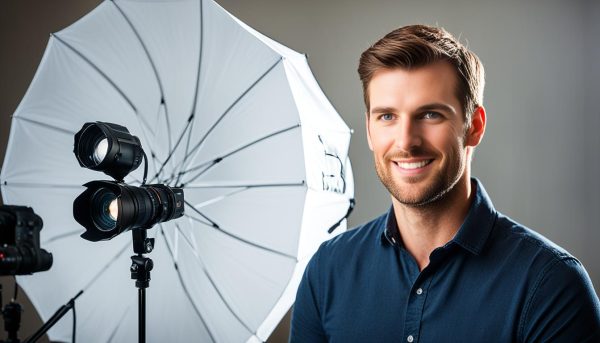Photography is more than just a hobby or profession; it can also serve as a powerful form of therapy for individuals seeking healing and emotional well-being. Through the lens, individuals can capture moments, process emotions, and embark on a journey of self-discovery. The therapeutic benefits of photography are numerous, and it has been shown to promote healing, reduce stress and anxiety, and foster personal growth.
Whether you are dealing with a challenging life transition, struggling with mental health issues, or simply looking for a creative outlet, photography therapy may offer a way to promote healing and find solace. By engaging with the creative process, individuals can gain insights into their emotions, values, and personal narratives. Furthermore, photography therapy offers a holistic approach to healing, nurturing both the mind and body.
Key Takeaways:
- Photography can be used as a form of therapy to promote healing and emotional well-being.
- Through photography therapy, individuals can capture moments, process emotions, and embark on a journey of self-discovery.
- The therapeutic benefits of photography extend beyond the photos themselves, promoting personal growth and reducing stress.
- Photography therapy offers a holistic approach to healing, nurturing both the mind and body.
- By incorporating photography into daily life, individuals can experience ongoing emotional well-being and personal growth.
Understanding the Therapeutic Value of Photography
Photography has long been a medium for capturing and preserving memories. However, it also offers a range of therapeutic benefits for emotional healing and self-expression. Engaging with photography as a form of therapy can help individuals process their experiences, emotions, and thoughts in a meaningful way.
Photography therapy involves using the act of taking pictures as a tool for promoting mental and emotional well-being. Through the lens, individuals can explore and express their inner world, providing a safe and creative outlet for self-exploration.
One of the therapeutic values of photography is its ability to support emotional healing. By capturing moments that evoke strong feelings, individuals can process and make sense of their emotions in a visual way. This can help them gain a deeper understanding of themselves and their experiences, leading to a sense of clarity and release.
Photography also serves as a powerful means of self-expression. It encourages individuals to tap into their creativity and communicate their thoughts and emotions in a unique way. Through photography, individuals can share their personal narratives and perspectives, promoting a deeper connection to themselves and others.
Furthermore, photography therapy can help individuals develop new skills and abilities. As they engage in the creative process, they may discover new perspectives, strengths, and insights. This can lead to personal growth and a greater sense of empowerment.
“Photography takes an instant out of time, altering life by holding it still.” – Dorothea Lange
Exploring the Mind-Body Connection in Photography Therapy
The mind and body are deeply interconnected, and when it comes to emotional well-being, it’s essential to address both. Photography as therapy takes a holistic approach that encourages the nurturing of both the mind and body to achieve a positive and lasting impact on one’s emotional state.
When individuals engage with the creative process of capturing images, they stimulate their minds and encourage emotional expression. The process of composing and framing a shot can help individuals become more aware of their thoughts and feelings, promoting self-reflection and introspection.
Beyond the mental and emotional benefits, the practical act of taking photographs can also have a positive impact on the body. Photography often involves getting outdoors, engaging in physical activity, and experiencing the world from a different perspective, all of which contribute to a healthier lifestyle and improved well-being.
Moreover, photography therapy utilizes elements of mindfulness and meditation, which have been shown to reduce stress and promote relaxation. Mindfulness-based practices like deep breathing and visualization can help individuals become more in tune with their bodies, calm their minds, and reduce symptoms of depression and anxiety.
Photography and Emotional Well-Being
Engaging with photography in a therapeutic context can help individuals connect with their emotions and express them in a healthy and constructive way. For example, taking photos of nature can evoke feelings of peace and tranquility, while capturing moments of laughter or joy can foster a sense of gratitude and contentment.
Photography can also serve as a tool for processing difficult emotions like grief, trauma, and loss. By documenting their experiences, individuals can gain a deeper understanding of their emotions and find new ways to cope and heal.
Using a Holistic Approach to Healing Through Photography
Photography therapy offers a holistic approach to healing by addressing both the mind and body. By engaging with the creative process, individuals can stimulate their minds, encourage emotional expression, and engage in physical activity, all of which can contribute to improved emotional well-being.
Moreover, photography therapy encourages a deeper connection with oneself and the world around them. It fosters a sense of mindfulness and presence, which can help individuals appreciate the beauty of life and find meaning and purpose in their experiences.
Overall, photography therapy offers a unique and powerful way to promote emotional healing and well-being. By exploring the mind-body connection through the lens, individuals can gain new insights, find solace, and embark on a journey of self-discovery and growth.
Benefits of Photography Therapy for Mental Health
Photography therapy has been found to have numerous benefits for individuals struggling with mental health issues such as anxiety and depression. Through capturing images, individuals can express their emotions and gain a sense of control over their experiences.
Photography can serve as a powerful coping mechanism, allowing individuals to focus on the present moment and channel their energy into a creative outlet. The act of taking photos can be therapeutic in itself, promoting a sense of accomplishment and boosting self-esteem.
Studies have shown that photography therapy can help individuals process traumatic experiences and reduce symptoms of anxiety and depression. By engaging in a creative process, individuals are able to reframe their experiences in a positive light and gain a new perspective on their circumstances.
“Photography allows me to express emotions that I cannot put into words. It’s a way for me to cope with my depression and anxiety, and it gives me a sense of purpose and accomplishment.” – Sarah, photography therapy participant
| Benefits of Photography Therapy for Mental Health | Examples |
|---|---|
| Reduces symptoms of anxiety and depression | A participant in a photography therapy program reported a decrease in anxiety and depression symptoms after regularly engaging in the practice for several months. |
| Fosters self-esteem and a sense of accomplishment | Individuals who struggle with low self-esteem may benefit from the creative outlet and positive reinforcement provided by photography therapy. |
| Serves as a coping mechanism | Individuals dealing with stressful situations or emotional turmoil can use photography as a productive and therapeutic outlet for their emotions. |
Overall, photography therapy has shown promise as an effective and holistic approach to promoting mental health and emotional well-being. By incorporating the practice into their daily lives, individuals can experience the transformative power of creative self-expression and gain new insights into their experiences.
Photography as a Tool for Self-Reflection and Growth
Photography is not just about capturing beautiful images; it can also be a powerful tool for self-reflection and personal growth. Through the process of taking photos, individuals can explore their emotions, values, and personal narratives in a creative and meaningful way. Let’s delve deeper into the ways in which photography can help individuals achieve self-discovery and personal growth.
Self-Reflection Through Photography
Photography provides a unique opportunity for self-reflection. Through the lens, individuals can capture their perceptions of the world around them, including their own experiences and emotions. By examining these images, individuals can gain insights into their own thought processes and gain a deeper understanding of themselves.
Personal Growth Through Photography
Photography can also facilitate personal growth by encouraging individuals to step outside of their comfort zones and explore new perspectives. When individuals engage in photography, they are encouraged to take risks, experiment with new techniques, and try different subject matter. Through this process, individuals can gain confidence in their abilities and develop new skills.
“Photography takes an instant out of time, altering life by holding it still.”
– Dorothea Lange
Self-Discovery with Photography
One of the most powerful aspects of photography is its ability to foster self-discovery. Through the act of capturing images, individuals can uncover hidden aspects of themselves and gain a deeper understanding of their own emotions and experiences. Photography can serve as a means of uncovering personal truths and promoting self-acceptance.
Whether it’s through capturing moments of beauty in nature, exploring the city streets, or photographing personal relationships, photography can serve as a means of exploring one’s self and promoting personal growth.
As individuals engage in photography, they can develop a heightened awareness of their surroundings and emotions. This mindfulness can lead to greater self-awareness and a deeper connection to the world around them. By incorporating photography into daily life, individuals can embark on a journey of self-discovery and personal growth.
Techniques and Practices for Therapeutic Photography
Engaging in therapeutic photography can be a transformative experience, but it takes practice and intentionality to fully reap its benefits. Here are some techniques and practices to consider:
1. Mindfulness in Photography
Mindfulness is the practice of being present and fully engaged in the current moment. It can enhance the therapeutic value of photography by encouraging individuals to focus on the details and emotions present in the scene they are capturing. To incorporate mindfulness into your photography practice, try the following:
- Take a moment to breathe deeply and center yourself before you begin photographing
- Focus on the details of the scene, using all your senses to fully engage with it
- Pay attention to your emotions as you capture the image
- Acknowledge any distracting thoughts that arise, but gently bring your focus back to the present moment
2. Using Photography for Stress Relief
Photography can serve as a tool for stress relief by providing a healthy and creative outlet for processing emotions. To use photography for stress relief, try the following:
- Find a peaceful or inspiring location to photograph
- Focus on capturing images that evoke positive emotions, such as joy or wonder
- Try photography exercises designed specifically for stress relief, such as capturing the color blue or taking macro images of nature
- Take the time to breathe deeply and relax as you engage in your photography practice
3. Unique Therapeutic Photography Techniques
There are several unique techniques that can enhance the therapeutic value of photography:
| Technique | Description |
|---|---|
| Double Exposure | Layering two or more images to create a composite that represents emotional depth and complexity |
| Self-Portraits | Using photography as a means of self-exploration and self-expression through capturing images of oneself |
| Abstract Photography | Using color, shape, and composition to evoke emotions and encourage introspection |
4. Editing and Processing Your Images
Editing and processing your images can be a valuable part of the therapeutic process, allowing you to further explore your emotions and creative vision. Some editing techniques to consider include:
- Enhancing the colors and contrast to create a mood
- Cropping and adjusting the composition to draw attention to specific details
- Experimenting with different filters and effects to create unique interpretations of the image
- Using editing as a means of introspection and reflection
Remember, there are no rules or right or wrong ways to engage in therapeutic photography. The key is to find techniques and practices that resonate with you and allow you to tap into your creativity and emotions in a positive and healing way.
Creating a Safe Space for Photography Therapy
In photography therapy, creating a safe space is critical to ensuring a positive and supportive environment for self-expression. Here are some guidelines to help establish a secure and non-judgmental space for photography therapy:
- Set clear boundaries: To create a safe and comfortable space, it’s important to establish clear guidelines around confidentiality, respect, and appropriate behavior. This helps to ensure that participants feel secure enough to share their thoughts and emotions freely.
- Encourage active listening: Active listening is a key component of creating a supportive environment for self-expression. Practitioners should encourage participants to actively listen to one another and avoid interrupting or judging each other.
- Show empathy: Practitioners should show empathy towards participants and acknowledge their emotions and experiences. This helps to foster a sense of trust and safety within the group.
- Avoid criticism: In photography therapy, the focus is on the process rather than the outcome. Practitioners should avoid criticism and judgment of the photographs taken by participants. Instead, they should encourage participants to reflect on their photos and the emotions they evoke.
- Respect diversity: Photography therapy should be a welcoming space for individuals of all backgrounds and experiences. Practitioners should ensure that their practices and language are inclusive and that everyone feels respected and valued.
By incorporating these guidelines into photography therapy sessions, practitioners can help create a safe and supportive space for self-expression and emotional healing.
“In a safe space, people can share their feelings and experiences without fear of judgment or criticism, which is essential for personal growth and healing.”
Stories of Healing and Transformation Through Photography
Photography therapy has the power to transform individuals’ lives and lead to emotional healing. Below are personal experiences that showcase the transformative power of photography:
“Photography has been my lifeline during some of the darkest times in my life. When I was struggling with anxiety and depression, picking up my camera allowed me to focus on the beauty around me and find solace in creativity. Through photography, I not only found a way to cope with my struggles, but I also uncovered a passion that has brought so much joy and fulfillment into my life.”
-Anonymous individual
The above quote illustrates how photography can act as a coping mechanism for individuals dealing with challenges, such as anxiety and depression. It also highlights how photography can lead to personal growth and discovery.
“I never thought I would be able to confront my past trauma, but photography gave me a new perspective on my experiences. It allowed me to express my emotions and process my memories in a way that felt safe and therapeutic. Through photography therapy, I was able to find a sense of closure and move forward with a newfound confidence.”
-Anonymous individual
The power of photography therapy is evident in this quote, as it demonstrates how engaging with the creative process can lead to emotional healing and growth.
These stories of healing and transformation are just a few examples of the significant impact that photography therapy can have on individuals. Through self-expression and creativity, individuals can explore their emotions, uncover new perspectives, and embark on a journey of personal growth.
Integrating Photography Therapy into Daily Life
Photography therapy can be a powerful tool for promoting emotional well-being and self-care, and integrating it into your daily routine can have lasting benefits. Here are some tips for incorporating photography therapy into your life:
- Take a daily photo: Find a subject that inspires you and capture a photo every day. This can be a moment of mindfulness and self-reflection.
- Use photography for stress relief: When you’re feeling overwhelmed, take a break and snap some photos. Allow yourself to be present in the moment and focus on the creative process.
- Incorporate photography into mindfulness practice: Use photography as a form of meditation, paying attention to the details of your surroundings and capturing moments of beauty and gratitude.
- Explore photography as a form of self-care: Set aside time to engage with your camera and capture images that make you happy or uplifted. This can be a form of self-nurturing and help build self-esteem.
By integrating photography therapy into your daily life, you can tap into its therapeutic benefits and promote ongoing emotional well-being. Whether it’s through capturing moments of beauty, exploring your emotions through self-expression, or finding solace and inspiration, photography can be a powerful tool for healing and growth.
Conclusion
Photography as therapy provides a unique and powerful avenue for finding healing and promoting emotional wellness. Through the creative process of capturing moments through the lens, individuals can express their emotions, tap into their creativity, and embark on a journey of self-discovery.
The Transformative Power of Photography Therapy
The therapeutic value of photography extends beyond the photos themselves, allowing individuals to find solace, gain insights, and experience personal growth. The stories of healing and transformation through photography therapy serve as inspirational examples of the transformative power of the practice.
Integrating Photography Therapy into Daily Life
It is important to incorporate photography therapy into daily life to experience ongoing emotional well-being. Regularly engaging with photography offers a practical and effective way to practice self-care, mindfulness, and personal growth.
Final Thoughts
By creating a safe space for photography therapy and following the recommended techniques and practices, individuals can experience the full benefits of this unique and powerful form of therapy. Anyone can benefit from photography therapy, regardless of their skill level or experience with photography. When used as a tool for self-reflection and growth, photography has the potential to promote healing and emotional well-being.
FAQ
What is photography therapy?
Photography therapy is a form of therapeutic practice that utilizes photography as a tool for promoting healing and emotional well-being. It involves capturing moments through the lens to express emotions, process experiences, and embark on a journey of self-discovery.
What are the therapeutic benefits of photography?
Photography offers numerous therapeutic benefits, including serving as a form of self-expression, promoting emotional healing, and enhancing self-esteem. It can also be a coping mechanism for individuals dealing with anxiety, depression, or other mental health challenges.
How does photography therapy promote self-growth?
Photography therapy encourages self-reflection and personal growth by providing a means to explore emotions, values, and personal narratives. Through capturing images, individuals can gain insights into their own inner strengths and embark on a journey of self-discovery.
Can photography be integrated into daily life for ongoing emotional well-being?
Yes, photography therapy can be integrated into daily life for ongoing emotional well-being. It can be used as a form of self-care, incorporated into mindfulness practices, and provide a creative outlet for expressing emotions and engaging with the world around us.
What techniques can enhance the therapeutic experience of photography?
Techniques such as mindfulness in photography, using specific photographic techniques, and practicing stress relief through photography can enhance the therapeutic experience. These techniques encourage a deeper engagement with the creative process and facilitate the exploration of emotions.
How do you create a safe space for photography therapy?
Creating a safe space for photography therapy involves establishing a supportive and non-judgmental environment. Practitioners and participants should foster an atmosphere that encourages self-expression, respects individual experiences, and ensures confidentiality and trust.
Are there any success stories of healing through photography therapy?
Yes, there are many success stories of individuals who have experienced healing and transformation through photography therapy. These stories highlight how photography has helped people navigate challenges, find solace, and discover their inner strengths.
How can photography therapy benefit mental health?
Photography therapy can benefit mental health by serving as a coping mechanism, promoting self-esteem, and offering a creative outlet for emotional expression. It can also provide individuals with a sense of accomplishment and a tool for managing anxiety, depression, and other mental health challenges.
What is the mind-body connection in photography therapy?
The mind-body connection in photography therapy emphasizes how engaging with the creative process can have a positive impact on emotional well-being. It recognizes that the act of capturing moments through the lens can nurture and balance both the mind and body.
How can photography therapy be incorporated into a holistic approach to healing?
Photography therapy can be incorporated into a holistic approach to healing by recognizing the interconnectedness of the mind, body, and spirit. It encourages individuals to engage in self-reflection, explore emotions, and discover personal growth through the creative process of capturing images.






